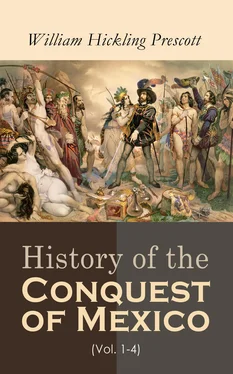[124]The traditions of their origin have somewhat of a fabulous tinge. But, whether true or false, they are equally indicative of unparalleled ferocity in the people who could be the subject of them. Clavigero, Stor. del Messico, tom. i. p. 167, et seq.; also Humboldt (who does not appear to doubt them), Vues des Cordillères, p. 95.
[125][According to Payne, New World Called America, i. p. 78, Tezcatlipoca, or Fiery Mirror , was so called because of the shield of polished metal which was almost always a conspicuous adjunct of the idol which represented him. Probably the correct form of his name is Tezcatlipopoca, or Fiery Smoking Mirror. He had many names: “Night Wind,”—“whose servants we are,”—“The Impatient,”—“The Provident Disposer,”—“who does what he will.” His best-known appellation was Telpochtli, or “Youthful Warrior,” because his vital force was never diminished. He was also called the “Enemy,” and the “Hungry Chief.”—He always had a living representative; when one was sacrificed another took his place, and this representative was invested with the dress, functions, and attributes of the God himself.—M.]
[126]Sahagun, Hist. de Nueva-España, lib. 2, cap. 2, 5, 24, et alibi.—Herrera, Hist. general, dec. 3, lib. 2, cap. 16.—Torquemada, Monarch. Ind., lib. 7, cap. 19; lib. 10, cap. 14.—Rel. d’un gentil’ huomo, ap. Ramusio, tom. iii. fol. 307.—Acosta, lib. 5, cap. 9-21.—Carta del Lic. Zuazo, MS.—Relacion por el Regimiento de Vera Cruz (Julio, 1519), MS.—Few readers, probably, will sympathize with the sentence of Torquemada, who concludes his tale of woe by coolly dismissing “the soul of the victim, to sleep with those of his false gods, in hell!” Lib. 10, cap. 23.
[127]Sahagun, Hist. de Nueva-España, lib. 2, cap. 10, 29.—Gomara, Crón., cap. 219, ap. Barcia, tom. ii.—Toribio, Hist. de los Indios, MS., Parte 1, cap. 6-11.—The reader will find a tolerably exact picture of the nature of these tortures in the twenty-first canto of the “Inferno.” The fantastic creations of the Florentine poet were nearly realized, at the very time he was writing, by the barbarians of an unknown world. One sacrifice, of a less revolting character, deserves to be mentioned. The Spaniards called it the “gladiatorial sacrifice,” and it may remind one of the bloody games of antiquity. A captive of distinction was sometimes furnished with arms, and brought against a number of Mexicans in succession. If he defeated them all, as did occasionally happen, he was allowed to escape. If vanquished, he was dragged to the block and sacrificed in the usual manner. The combat was fought on a huge circular stone, before the assembled capital. Sahagun, Hist. de Nueva-España, lib. 2, cap. 21.—Rel. d’un gentil’ huomo, ap. Ramusio, tom. iii. fol. 305.
[128]Sahagun, Hist. de Nueva-España, lib. 2, cap. 1, 4, 21, et alibi.—Torquemada, Monarch. Ind., lib. 10, cap. 10.—Clavigero, Stor. del Messico, tom. ii. pp. 76, 82.
[129]Carta del Lic. Zuazo, MS.—Torquemada, Monarch. Ind., lib. 7, cap. 19.—Herrera, Hist. general, dec. 3, lib. 2, cap. 17.—Sahagun, Hist. de Nueva-España, lib. 2, cap. 21, et alibi.—Toribio, Hist. de los Indios, MS., Parte 1, cap. 2.
[130]To say nothing of Egypt, where, notwithstanding the indications on the monuments, there is strong reason for doubting it. (Comp. Herodotus, Euterpe, sec. 45.) It was of frequent occurrence among the Greeks, as every schoolboy knows. In Rome, it was so common as to require to be interdicted by an express law, less than a hundred years before the Christian era,—a law recorded in a very honest strain of exultation by Pliny (Hist. Nat., lib. 30, sec. 3, 4); notwithstanding which, traces of the existence of the practice may be discerned to a much later period. See, among others, Horace, Epod., In Canidiam.
[131]See Clavigero, Stor. del Messico, tom. ii. p. 49.—Bishop Zumárraga, in a letter written a few years after the Conquest, states that 20,000 victims were yearly slaughtered in the capital. Torquemada turns this into 20,000 infants . (Monarch. Ind., lib. 7, cap. 21.) Herrera, following Acosta, says 20,000 victims on a specified day of the year, throughout the kingdom. (Hist. general, dec. 2, lib. 2, cap. 16.) Clavigero, more cautious, infers that this number may have been sacrificed annually throughout Anahuac. (Ubi supra.) Las Casas, however, in his reply to Sepulveda’s assertion, that no one who had visited the New World put the number of yearly sacrifices at less than 20,000, declares that “this is the estimate of brigands, who wish to find an apology for their own atrocities, and that the real number was not above 50”! (Œuvres, ed. Llorente (Paris, 1822), tom. i. pp. 365, 386.) Probably the good Bishop’s arithmetic here, as in most other instances, came more from his heart than his head. With such loose and contradictory data, it is clear that any specific number is mere conjecture, undeserving the name of calculation.
[132]I am within bounds. Torquemada states the number, most precisely, at 72,344 (Monarch. Ind., lib. 2, cap. 63); Ixtlilxochitl, with equal precision, at 80,400. (Hist. Chich., MS.) ¿Quien sabe? The latter adds that the captives massacred in the capital, in the course of that memorable year, exceeded 100,000! (Loc. cit.) One, however, has to read but a little way, to find out that the science of numbers—at least where the party was not an eyewitness—is anything but an exact science with these ancient chroniclers. The Codex Telleriano-Remensis, written some fifty years after the Conquest, reduces the amount to 20,000. (Antiq. of Mexico, vol. i. Pl. 19; vol. vi. p. 141, Eng. note.) Even this hardly warrants the Spanish interpreter in calling king Ahuitzotl a man “of a mild and moderate disposition,” templada y benigna condicion ! Ibid., vol. v. p. 49.
[133]Gomara states the number on the authority of two soldiers, whose names he gives, who took the trouble to count the grinning horrors in one of these Golgothas, where they were so arranged as to produce the most hideous effect. The existence of these conservatories is attested by every writer of the time.
[134]The “Anonymous Conqueror” assures us, as a fact beyond dispute, that the Devil introduced himself into the bodies of the idols, and persuaded the silly priests that his only diet was human hearts! It furnishes a very satisfactory solution, to his mind, of the frequency of sacrifices in Mexico. Rel. d’un gentil’ huomo, ap. Ramusio, tom. iii. fol. 307.
[135]The Tezcucan priests would fain have persuaded the good king Nezahualcoyotl, on occasion of a pestilence, to appease the gods by the sacrifice of some of his own subjects, instead of his enemies; on the ground that they would not only be obtained more easily, but would be fresher victims, and more acceptable. (Ixtlilxochitl, Hist. Chich., MS., cap. 41.) This writer mentions a cool arrangement entered into by the allied monarchs with the republic of Tlascala and her confederates. A battle-field was marked out, on which the troops of the hostile nations were to engage at stated seasons, and thus supply themselves with subjects for sacrifice. The victorious party was not to pursue his advantage by invading the other’s territory, and they were to continue, in all other respects, on the most amicable footing. (Ubi supra.) The historian, who follows in the track of the Tezcucan Chronicler, may often find occasion to shelter himself, like Ariosto, with
“Mettendolo Turpin, lo metto anch’ io.”
[136][Don José F. Ramirez, the distinguished Mexican scholar, has made this sentence the text for a disquisition of fifty pages or more, one object of which is to show that the existence of human sacrifices is not irreconcilable with an advance in civilization. This leads him into an argument of much length, covering a broad range of historical inquiry, and displaying much learning as well as a careful consideration of the subject. In one respect, however, he has been led into an important error by misunderstanding the drift of my remarks, where, speaking of cannibalism, I say, “It is impossible the people who practise it should make any great progress in moral or intellectual culture” (p. 100). This observation, referring solely to cannibalism, the critic cites as if applied by me to human sacrifices. Whatever force, therefore, his reasoning may have in respect to the latter, it cannot be admitted to apply to the former. The distance is wide between human sacrifices and cannibalism; though Señor Ramirez diminishes this distance by regarding both one and the other simply as religious exercises, springing from the devotional principle in our nature.{*} He enforces his views by a multitude of examples from history, which show how extensively these revolting usages of the Aztecs—on a much less gigantic scale indeed—have been practised by the primitive races of the Old World, some of whom, at a later period, made high advances in civilization. Ramirez, Notas y Esclarecimientos á la Historia del Conquista de México del Señor W. Prescott, appended to Navarro’s translation.]
Читать дальше












